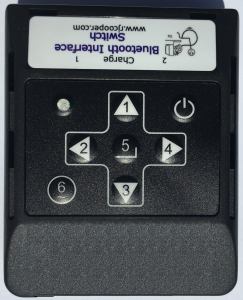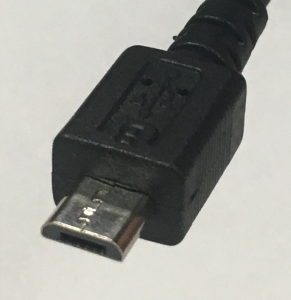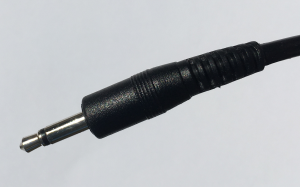Summary
A wireless (Bluetooth) switch interface allows a switch to activate software on a dynamic touchscreen device (e.g., an iPad); in contrast, we use a wired interface for conventional computers. The interface pretends to send signals from a keyboard, such as space and enter.
Contact Information
Trace Mansfield
tmansfield@lesd.k12.or.us
Page Contents
Equipment Image
The label on the following device is upside down compared to some others of this type; in other words, on most of these devices, the label will show the ‘1’ and ‘2’ in positions opposite to this. It doesn’t really matter, though, because you will (nonetheless) find two switch cable ports on the end of the device (3.5mm), one to either side of the charging port (micro-USB). A switch in one of those ports will send a space signal, and the other will act as enter. So the best way to figure out which port does what is to just plug in a switch and see what it does.
The micro-USB cable (used for charging) is the type that has the thinnest end:
This is the conventional 3.5 mm plug used on most switches. For older switches that have a ¼-inch plug, just use an adapter.
Instructions
Up to 2 switches can connect to your device with this “keyboard emulator.”
Turn the interface on/off
- Power on: press and hold power button until the light to the left blinks. If that light…
- stays orange, then the interface needs recharging.
- stays red, then it really needs recharging.
- blinks green, then it is in “discoverable” mode and is ready for pairing. (See below.)
- stays green, then you are ready to go.
- blinks orange intermittently, then it is signaling back and forth with the device (and ready to go).
- Power off: press and hold power button until the light flashes red 3 times, then release.
Pair with Bluetooth
- The blinking green light will mean that the device is looking to pair with a device (like an iPad).
- Go to Settings, and if Bluetooth is not already turned on, do so.
- Look for a device on the list that will be named ‘AirTurn’ plus something, such as ‘AirTurn106v143-EFA7’, then select ‘Connect’.
Use a switch
- Plug a switch into one of the ports on the interface.
- Open the Notes app on an iPad (to use as a test), and start a new note. (The iPad onscreen keyboard should not appear, because the iPad is now treating switch input as its keyboard.)
- Whenever you activate the switch, the cursor in Notes should react either as if you had typed space or enter (depending on which interface port you are using).
- In other apps, space will step you through the scanning of items, and enter will select the current item. In straightforward cause-and-effect apps, you will just use enter because you will only be given one choice at a time. (Apps that are programmed for specific responses to space and enter keystrokes will react accordingly.)
Troubleshooting
- If no ‘AirTurn’ device shows up on the Bluetooth list, press and hold the Power button on the interface until the light rapidly flashes red/green. It will be back in “discoverable” mode, and should show up.
- If an ‘AirTurn’ device does show up on the Bluetooth list but will not connect, then (a) select the blue ⓘ to the right of the device name, (b) select “Forget this Device,” and then (c) try again.
Notes
This interface will also work with specific built-in iPad apps if you change the “profile.” To make that change, do the following (when the interface is turned ON):
- Music: Press and hold the ⑥ button for 2 flashes. You can use one switch for Play/Pause, and another for Next Song. (We recommend instead using the regular profile with the app “Switch Access Training with a Music.”)
- Camera: Press and hold the ⑥ button for 3 flashes. You can use a switch to snap a picture. (It is better to use the regular profile with the app “Switch Access Training with a Camera.”)
- Books: Press and hold the ⑥ button for 4 flashes. This allows a switch to act as the Select button in VoiceOver, but is erratic in its behavior.
- To RESET to the default profile: Press and hold the ⑥ button for 1 flash.


